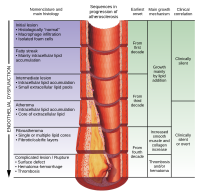
Photo from wikipedia
Objective Adenosine triphosphate (ATP)-binding cassette transporter A1 (ABCA1) influences hepatic cholesterol transportation. Accumulation of hepatic cholesterol leads to fatty liver disease, which is improved by glucagon-like peptide 1 (GLP-1) in… Click to show full abstract
Objective Adenosine triphosphate (ATP)-binding cassette transporter A1 (ABCA1) influences hepatic cholesterol transportation. Accumulation of hepatic cholesterol leads to fatty liver disease, which is improved by glucagon-like peptide 1 (GLP-1) in diabetes. Therefore, we analyzed the molecular mechanism in the regulation of hepatic ABCA1 by GLP-1 analogue exendin-4. Methods Hepatic ABCA1 expression and transcription were checked by western blotting, real-time polymerase chain reaction (PCR), and luciferase assay in HepG2 cells. Chromatin immunoprecipitation (ChIP) and site-directed mutagenesis were employed to determine transcriptional regulation of the ABCA1 gene. Prolactin regulatory element-binding (PREB)-transgenic mice were generated to access the effect of exendin-4 on improving lipid accumulation caused by a high-fat diet (HFD). Results Exendin-4 stimulated hepatic ABCA1 expression and transcription via the Ca2+/calmodulin (CaM)-dependent protein kinase kinase/CaM-dependent protein kinase IV (CaMKK/CaMKIV) pathway, whereas GLP-1 receptor antagonist exendin9-39 cancelled this effect. Therefore, exendin-4 decreased hepatic lipid content. ChIP showed that PREB could directly bind to the ABCA1 promoter, which was enhanced by exendin-4. Moreover, PREB stimulated ABCA1 promoter activity, and mutation of PREB-binding site in ABCA1 promoter cancelled exendin-4-enhanced ABCA1 promoter activity. Silencing of PREB attenuated the effect of exendin-4 and induced hepatic cholesterol accumulation. Blockade of CaMKK by STO-609 or siRNA cancelled the upregulation of ABCA1 and PREB induced by exendin-4. In vivo, exendin-4 or overexpression of PREB increased hepatic ABCA1 expression and decreased hepatic lipid accumulation and high plasma cholesterol caused by a HFD. Conclusions Our data shows that exendin-4 stimulates hepatic ABCA1 expression and decreases lipid accumulation by the CaMKK/CaMKIV/PREB pathway, suggesting that ABCA1 and PREB might be the therapeutic targets in fatty liver disease.
Journal Title: Molecular Metabolism
Year Published: 2020
Link to full text (if available)
Share on Social Media: Sign Up to like & get
recommendations!